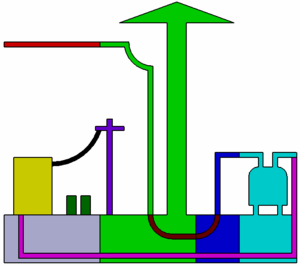Power lines
There are more power infrastructure in the real world than just a power plug and socket. The socket on the wall is just the end of a big grid which is supplied with electric energy through a transportation and distribution network. This is a scheme of some infrastructure.
Summary of values
Influenced by: discussion on Talk:key:power, User:Adjuva/PowerTagging, Matthew Newton, Bahnpirat
Personal statement: confusions between power=station and power=sub_station are my (Bahnpirat) fault. The following draft use the correct English meaning and "station" is no longer a tag here.
| OSM-key (colour) | English | German | |
|---|---|---|---|
| High voltage overhead power line | Hochspannungsfreileitung (400-50 kV) | ||
| High voltage earth cables | Hochspannungserdkabel (400-50 kV) | ||
| Smaller tower, made of wood or stone | Mittelspannungsmast (z.B. aus Holz oder Beton) | ||
| Smaller overhead line | Mittelspannungfreileitung (55-1 kV) | ||
| Low to medium voltage underground power cable | Mittelspannungkabel (50-1 kV) | ||
location:transition=yes |
Power tower where overhead line transitions into underground cable. | Erdkabelübergang - Freileitung wechselt zu Erdkabel | |
| Underground cable go overground inside a sub station | Erdkabelübergang im Umspannwerk | ||
| High voltage transformer | Hochspannungstransformator (> 100 kV) | ||
| Distribution for local area | Trafohäuschen | ||
| Distribution cabinet in a street | Verteilerkasten | ||
Keys and values
| Key | Value | Element | Description en | Beschreibung de |
|---|---|---|---|---|
| power | line | An overhead high voltage power line | oberirdische Hochspannungsleitung | |
| power | cable | An underground high voltage "line" | Hochspannungsleitung unter der Erde. | |
| power | tower | A pylon/tower supporting a power line | Ein Strommast, welcher die Leitung trägt. | |
| cables | 2;3;4;6 | Number of cables per power line/system. | Anzahl der Kabel pro "Leitung"/System. | |
| frequency | * | Frequency as integer value, omit the unit (Hz). 50 hertz is the European standard. 60 hertz is used from North America to the north of South America and in Japan and Taiwan. DC would be 0 hertz. The own power grid for railways in Austria, Germany and Switzerland uses 16.7 hertz | Standard ist 50 hertz für Europa und 60 hertz für Nordamerika und den nördlichen Teil von Südamerika sowie Japan und Taiwan; Gleichstrom (DC) wäre hier 0, eigenes Hochspannungsnetz der Bahnen in Österreich, Deutschland, Schweiz benutzt 16.7 hertz. | |
| voltage | * | Voltage as integer value. Please use the SI unit volt, but do not append it to the value. | Spannung in Volt. Ohne Punkt/Komma oder Einheit. | |
| name (or ref) | * | Name or reference of the power line. This value is consistent along the line. | Name oder Nummer der Hochspannungsleitung. Diese ist über die ganze Strecke gleich. | |
| operator | * | Name of the line operator. If more than one operator is responsible (hybrid power line), list them divided by a semicolon like operator=EON;Vattenfall in alphabetic order. | Name des Betreibers. | |
| source | GPS survey Yahoo ... |
Source of position and/or other information | Quelle der Position und/oder anderer Informationen. |
The whole thing
A power line is carried on power=towers, but may be supported by power=poles, especially on lines in the subtransmission grid, that connects the main grids with the distribution grid. Minor power lines are usually supported by poles, but towers may support such lines in rare cases. Three cables or conductors correspond one circuit (except traction power lines, high voltage direct current/HVDC, single wire earth return, and double or single wire branches of three-wire systems, usually for serving small customers). Every circuit has one voltage=* level on which it operate. Draw one way for all circuits connected to one power tower or pole. All lines for 50 kV or more are power=line. For lines with lower voltages that this, use power=minor_line. Use power=cable for underground, underwater, or overhead insulated power cables. name=* should be used for the name of the line (can be found below transmission towers), and ref=* corresponds to the line alphanumeric reference, that may be numbers, letters, or a combination of them.

Power transmission towers or poles may have numbers/names on it. Tower or pole numbers increase from start to end point, but other numbering systems exist. Names or numbers for each systems can be found on power towers and are the same at each tower or pole. These belong to the power=line and should be tagged on the way itself. Use source=survey if you track them! Poles can also carry a power line, mostly up to the "subtransmission" voltage levels (50-161 kV). Towers may exist on "minor" lines (power=minor_line)
Technical facts
Wires
- wires=* means the bundling of conductors which hang on insulators. Possible values : single, double, triple, quad ... (table from User:Nahainec/PowerLine)
- cables=* count the number of used conductors shielded by insulators on the tower or pole. Usually multiples of three (3, 6, 9, 12) but other numbers of conductors may exist, like in traction power lines (4, 8), high voltage direct current (usually 1 or 2), single wire earth return (1), or two or one wire branches of three wire lines (2, 1). This tag should not include ground cables, as they only serve are lightning protection and not used for electric power transmission.
- layer=* There are people connecting ways with power lines. Unless there is a broken line where wires lay at ground this is wrong. Layer=4 or 5 prevent lines going under a layer=2 building=*.
Circuits
Tag circuits=* allows mapper to represent to number of transit circuits.
Life cycle management
Like all infrastructure power lines are projected, constructed, used and may be deconstructed if it's disused.
- planned wind energy:
 power=planned, planned=generator, generator:source=wind
power=planned, planned=generator, generator:source=wind - power line under construction (may be not visible yet):
 power=construction, construction=line, operator=*
power=construction, construction=line, operator=*

